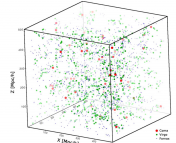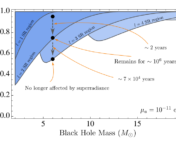Authors: Elena Asencio, Indranil Banik, and Pavel Kroupa
First author’s institution: Helmholtz-Institut für Strahlen und Kernphysik (HISKP), University of Bonn, Nussallee 14−16, D-53115 Bonn, Germany
Status: Accepted for publication in MNRAS, open access on arXiv
Our current best understanding of the properties of our Universe can be neatly summarised by the Lambda-Cold-Dark-Matter (LCDM) model, also known as a “concordance cosmology.” One of the key requirements of LCDM is that structures form hierarchically – i.e. smaller ones are created first, which, in turn, merge to form larger ones. Since galaxy clusters are the largest gravitationally collapsed objects, under LCDM, they are expected to have formed last. In fact, we can predict the number of clusters in our cosmos sorted according to their mass and their distance from us (redshift). This distribution is termed the cluster mass function. Spotting a galaxy cluster with a mass and distance that deviate significantly from the mass function could spell trouble from LCDM.
The Bullet Cluster and ACT-CL J0102-4915 (better known as El Gordo*) are two key insurgents. Both are extreme examples of colliding galaxy clusters with high velocities, the former of which was notably hailed as direct empirical proof of the existence of dark matter, as described in this Astrobite.
While the intriguing properties of the Bullet Cluster have been studied in detail, today’s authors argue that El Gordo is even more peculiar. It is the most massive galaxy cluster known above z ~ 0.6, weighing in at roughly (2-3) x 1015 solar masses (that’s 2-3 quadrillion Suns). The in-falling velocity of El Gordo, at roughly 2500 km/s compared to the Hubble flow, is too high based on the gravitating matter in each of the substructures alone, suggesting that possibly a third large object may be involved in the merging process (a very rare occurrence in LCDM predictions).
A knockout?
Using simulations, the authors suggest El Gordo formed from an off-centre collision between two clusters, yielding a total mass that is broadly in agreement with previous estimates using weak lensing measurements. The authors replicate the formation of El Gordo using galaxy cluster pairs with various masses, redshifts, impact parameters (the distance by which a collision deviates from being head-on) and infall velocities. They reproduce a mass function of simulated galaxy cluster pairs that fulfil the observed properties of El Gordo (“El Gordo analogues”), shown in Figure 1 below.
El Gordo is clearly an outlier in simulated LCDM mass functions for cluster pairs, illustrated by the fact the blue line intersects only with the tails of the orange, red and green lines (where the number of expected pairs is very, very small!) The authors validate these findings using a technique called lightcone tomography. Essentially they measure the number of cluster pairs at three redshift “snapshots” (tomography) and then extrapolate the number of expected pairs as a function of both mass and redshift (the lightcone) . This result is given in Figure 2.
The authors acknowledge that despite the rarity of this cluster, such anomalous clusters have only been observed in a small fraction of the entire sky. Hence, across larger survey volumes, outliers such as El Gordo may be less prominent, reducing the tension with LCDM. However, the authors state that “the ΛCDM model must be rejected at > 5σ confidence even if no additional problematic objects exist in the rest of the sky.” They go on to say that satellites such as Planck have already found more clusters that disrupt concordance cosmology predictions. One example is PLCK G287.0+32.9, a system of four merging clusters in which the largest is ten times more massive than the other components.
Or a comeback?
Curiously, the authors find that under a particular modification of Newtonian dynamics (termed MOND), clusters such as El Gordo might not be outliers after all. Within MOND theories, it is possible to enhance the formation of structures such as El Gordo compared to LCDM, leading to their existence at earlier times, and hence producing more of them. Today’s paper finds that the mass of El Gordo can be reduced by ~50% if computed according to MOND, further alleviating the tension with the observed mass function. However, an additional dark matter component is required to explain the mismatch between El Gordo’s visible and total mass. The authors find that repeating their simulations under assumptions of MOND and the inclusion of non-CDM candidate, the sterile neutrino, with a mass of ~11 eV, they are able to reproduce approximately 1 El Gordo pair in the surveyed volume, thereby matching observations. The authors attest to MOND’s credibility, stating that it may even resolve the longstanding Hubble conundrum, but acknowledge the properties of dark matter in the Bullet Cluster are difficult to dispute even with such modifications.
El Gordo gives us a tantalising glimpse into the glitches of our cosmos, suggesting that unconventional cosmologies may be the big winner on the cosmological lottery ticket. Future observations of El Gordo and Bullet-type clusters will tell us whether, in the words of a famous singer, LCDM is a tómbola after all.
*Spanish for “the big/fat one” to acknowledge both the size of the cluster and the Chilean contribution to the Atacama Cosmology Telescope. Fittingly, El Gordo is also the name of the grand prize in the Christmas Lottery popular across Spain and Latin America.
Astrobite edited by Lukas Zalesky.




